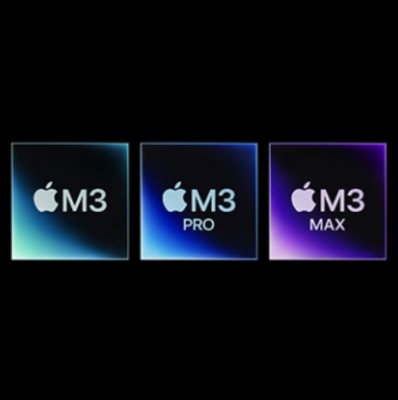Apple introduces its latest chip products: the M3, M3 Pro and M3 Max. These are the first personal computer chips to be manufactured using 3-nanometre process technology, representing a major advance in chip technology.
The process allows for denser packaging of transistors, resulting in increased speed and efficiency. With this announcement, Apple demonstrates the progress made since the introduction of the M1 chip family.
The GPUs in the M3 Series introduce several industry-first features. One of these is Dynamic Cache, a technique for judiciously utilising memory based on the task at hand. This optimises GPU utilisation and enhances performance in demanding applications and games. In addition, hardware-accelerated ray tracing, a technique for modelling light interactions within a scene, makes its Mac debut in the M3 Series. Combined with the new GPU architecture, professional applications can be up to 2.5 times faster than the M1 Series. Game developers, in particular, will benefit from photorealistic shadows and reflections from ray tracing, and the GPU also introduces hardware-accelerated mesh shading, providing improved geometry processing and richer visuals in games and graphics-intensive applications.
The M3 Series also outperforms in AI and video processing. An enhanced neural engine facilitates faster machine learning model processing. apps such as Topaz benefit from accelerated AI image processing tools, and software such as Adobe Premiere and Final Cut Pro gain performance improvements. The M3 Series' advanced media engine supports popular video codecs, and provides AV1 decoding for the first time.
Apple introduces its latest chip products: the M3, M3 Pro and M3 Max. These are the first personal computer chips to be manufactured using 3-nanometre process technology, representing a major advance in chip technology.
The process allows for denser packaging of transistors, resulting in increased speed and efficiency. With this announcement, Apple demonstrates the progress made since the introduction of the M1 chip family.
The GPUs in the M3 Series introduce several industry-first features. One of these is Dynamic Cache, a technique for judiciously utilising memory based on the task at hand. This optimises GPU utilisation and enhances performance in demanding applications and games. In addition, hardware-accelerated ray tracing, a technique for modelling light interactions within a scene, makes its Mac debut in the M3 Series. Combined with the new GPU architecture, professional applications can be up to 2.5 times faster than the M1 Series. Game developers, in particular, will benefit from photorealistic shadows and reflections from ray tracing, and the GPU also introduces hardware-accelerated mesh shading, providing improved geometry processing and richer visuals in games and graphics-intensive applications.
The M3 Series also outperforms in AI and video processing. An enhanced neural engine facilitates faster machine learning model processing. apps such as Topaz benefit from accelerated AI image processing tools, and software such as Adobe Premiere and Final Cut Pro gain performance improvements. The M3 Series' advanced media engine supports popular video codecs, and provides AV1 decoding for the first time.
0 Comments
0 Shares

 Change Language
Change Language